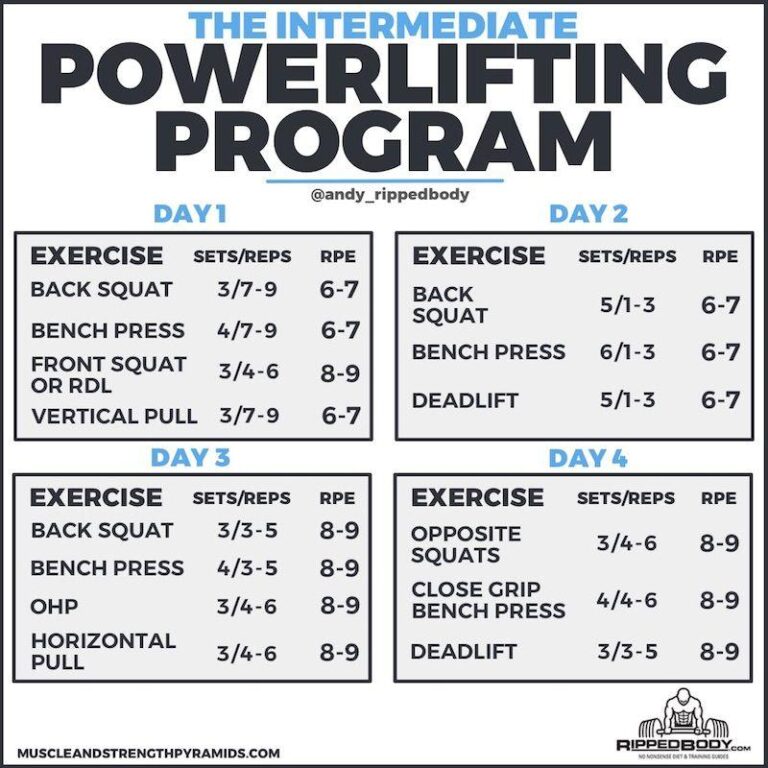If you’re serious about building raw strength and pushing yoru limits,a well-structured powerlifting training program is essential. Whether you’re a beginner aiming to master the foundational lifts or an experienced lifter looking to break through plateaus, the right approach can make all the difference. In this article, we’ll guide you through the ultimate powerlifting training program designed specifically for maximal strength gains. From workout structure and periodization to recovery strategies,get ready to elevate your performance and dominate the squat,bench press,and deadlift like never before.
Table of Contents
- Understanding the Fundamentals of Powerlifting: Technique and Form
- Designing a Periodized Training Schedule for maximum Strength
- Incorporating Accessory Exercises to Target Weak Points
- Optimizing Nutrition and Recovery for Enhanced Performance
- key Takeaways
Understanding the Fundamentals of Powerlifting: Technique and Form
Mastering the core mechanics of powerlifting is essential to not only maximize your strength gains but also to safeguard against injury. Each lift—squat, bench press, and deadlift—demands precise coordination of muscles, joints, and breathing patterns. As a notable example, maintaining a rigid torso during the squat protects the spine, while perfecting bar path on the bench press ensures optimal force transfer. Prioritizing proper alignment, engaging the right muscle groups, and executing controlled breathing are foundational components that translate into consistent progress on the platform.
To enhance your lifting technique, focus on these key elements:
- Bar Placement: Ensuring the bar is positioned correctly on your back or hands to maximize leverage.
- Foot Positioning: establishing a stable base wich influences balance and power generation.
- Breathing Technique: Utilizing the Valsalva maneuver to create intra-abdominal pressure and stabilize the core.
- Range of Motion: Completing each lift fully without sacrificing control.
- Tempo and Control: Managing lift speed to enhance muscle engagement and prevent momentum-assisted reps.
By integrating these technical milestones into your training regimen, you foster muscular efficiency and enhance neuromuscular connection, paving the way for sustained strength advancements.
Designing a Periodized Training Schedule for Maximum Strength
When crafting a training schedule aimed at maximizing strength, it’s essential to structure your workouts in phases that progressively challenge your neuromuscular system. Begin with a hypertrophy phase focusing on moderate loads and higher volume to build muscular endurance and size, which lays the foundational muscle mass necessary for future strength gains. Transition into a strength phase where the intensity increases and volume decreases, allowing the nervous system to adapt to heavier loads. This progression fosters improved motor unit recruitment and enhanced force production. incorporate a peaking phase with low volume and very high intensity to prepare for maximal lifts without overtaxing recovery resources.
Key elements to integrate into your periodized plan include:
- Planned deload weeks: systematically reduce training volume to facilitate recovery and prevent plateaus.
- Progressive overload: gradually increase weight, reps, or sets to continually challenge your muscles.
- Variation in exercise selection: incorporate accessory movements targeting weak points to enhance overall lift performance.
- Monitoring fatigue and recovery: adjust workload based on individual response to training stress.
Applying these principles with consistency and attentiveness will optimize your powerlifting journey and ensure your strength peaks precisely when it counts.
Incorporating Accessory Exercises to Target Weak Points
To maximize your powerlifting progress, it’s essential to complement your main lifts with targeted accessory exercises that directly address your individual weak points. These supplementary movements not only enhance muscular imbalances but also contribute to improved technique, joint stability, and overall force production. Integrating exercises like paused squats for improving lockout strength, deficit deadlifts for enhanced off-the-floor power, or close-grip bench presses to strengthen your triceps can create a well-rounded foundation for consistent gains.
Key benefits of accessory work include:
- Targeted muscle hypertrophy to support primary lifts
- Correction of biomechanical weaknesses and movement patterns
- Reduced injury risk through balanced muscular advancement
- Enhanced neuromuscular efficiency and coordination
By strategically incorporating these exercises into your routine, you can break through plateaus and create more robust, resilient strength adaptations that translate directly into your competition lifts.
Optimizing Nutrition and Recovery for Enhanced performance
Achieving maximal strength requires more than just lifting heavy; it demands a strategic approach to feeding your body and facilitating recovery. Prioritize a diet rich in quality proteins like lean meats, dairy, and plant-based options to support muscle repair and hypertrophy. Carbohydrates are equally essential, fueling intense training sessions and replenishing glycogen stores. Incorporate complex carbs such as sweet potatoes, oats, and brown rice for sustained energy. Don’t overlook healthy fats—avocados, nuts, and olive oil play pivotal roles in hormone production vital for muscle growth and recovery.
Recovery isn’t just about rest days; it’s a multifaceted process encompassing sleep, hydration, and active recovery techniques. Aim for 7-9 hours of quality sleep to enhance hormonal balance and cognitive function, critical components for consistent progress. Hydration supports nutrient transport and joint health, so maintain adequate fluid intake throughout the day. Integrate foam rolling,stretching,and light mobility drills post-workout to reduce muscle soreness and maintain adaptability. Together, these strategies create an optimal surroundings for strength gains and long-term performance enhancement.
- Protein: 1.2–2.0g per kg of body weight daily
- Carbohydrates: Emphasize timing around workouts
- Fats: Include sources rich in omega-3 fatty acids
- Sleep: Prioritize consistent sleep schedules
- Active Recovery: Use foam rolling and dynamic stretching
Key Takeaways
Incorporating the Ultimate Powerlifting training Program into your routine can be a game-changer for building serious strength and unlocking your full potential. Remember, consistency, proper form, and gradual progression are key to maximizing your gains while minimizing injury risk.Whether you’re a seasoned lifter or just starting out, this structured approach will help you push past plateaus and achieve new personal bests. Stay committed, listen to your body, and watch as your powerlifting journey transforms into one of steady, notable progress. Here’s to lifting smarter and stronger!

